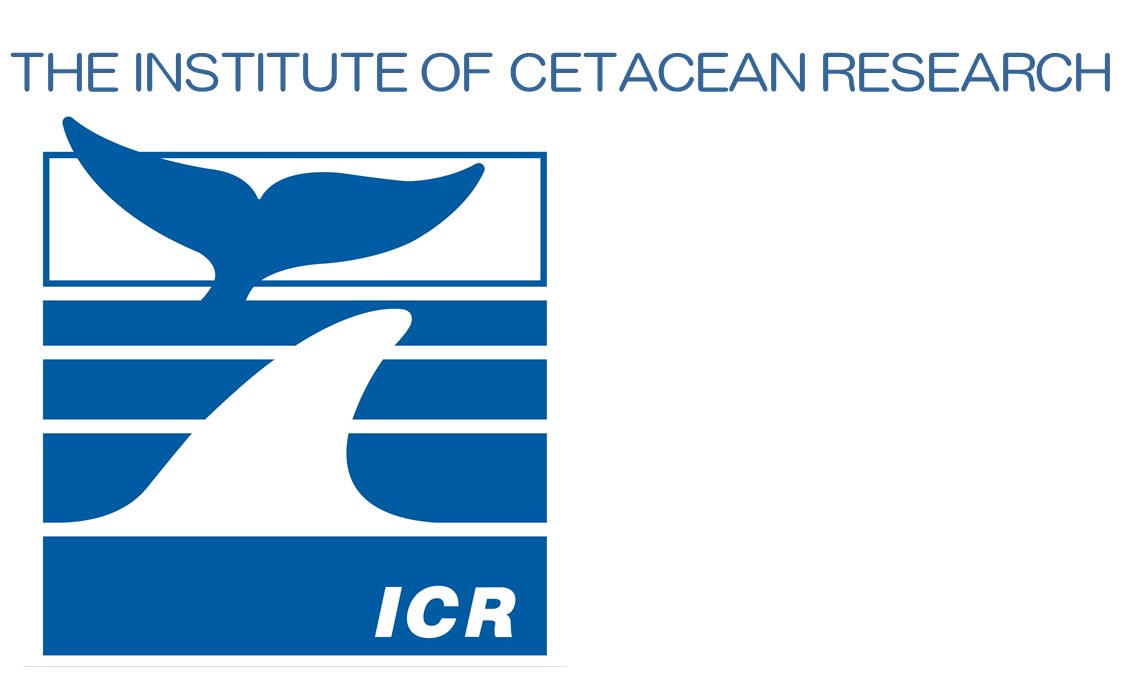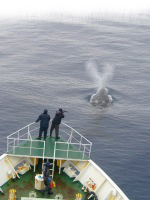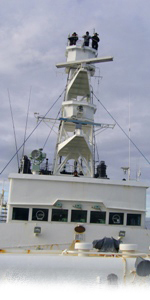Completion of the 2021 IWC/Japan Joint Cetacean Sighting Survey Cruise in the North Pacific
- IWC POWER
September 30, 2021
Designated Corporation for Scientific Whale Research
THE INSTITUTE OF CETACEAN RESEARCH
1. Background
This survey is conducted jointly by the International Whaling Commission (IWC) and Japan, and is commonly referred to by the IWC as the IWC-POWER (International Whaling Commission/Pacific Ocean Whale and Ecosystem Research). IWC-POWER is the successor of the IWC/SOWER (IWC-Southern Ocean Whale and Ecosystem Research), a successful IWC-Japan joint research program highly acclaimed globally, which was conducted in the Antarctic Ocean from 1996/1997 to 2009/2010. Taking advantage of the know-how, experience and achievements of the IWC/SOWER, IWC-POWER has been carried out every summer since 2010 in accordance with the main research agenda of the IWC Scientific Committee.
This survey is being conducted in the North Pacific Ocean, including the Northeast Pacific and the Bering Sea, where extensive whale sighting surveys had not been conducted for several decades. For the past eleven years, the IWC-POWER research cruises have found large numbers of fin and sei whales north of 40 degrees north latitude and a large number of Bryde’s and sperm whales in waters south of 40 degrees N, and valuable data have been collected to contribute to their stock assessment. In addition, information on rare species such as the blue and North Pacific right whales has also been collected.
As the 12th cruise, this time the research was conducted from August 2 to September 30 in the high seas north of 40 degrees north latitude and between 135-155 degrees west longitude in the northeast Pacific Ocean. Since the survey was to be conducted in waters far from Japan, there were no port calls. A Russian researcher was scheduled to participate, but due to the effects of the new coronavirus, he was unable to join, and the survey was conducted by US and Japanese researchers only.
2. Outline of the 2021 Research Cruise
The IWC-POWER program is conducted collaboratively by the International Whaling Commission and the Government of Japan. The POWER Steering Group (Convenor: Koji Matsuoka, Head, Stock Assessment and Management Division, ICR) established within the IWC/SC, formulated the plan and led the implementation of the research after the draft plan was approved by the IWC/SC. The Institute of Cetacean Research, under the commission of the Fisheries Agency of Japan, carried out the survey in cooperation with various research organizations, including the Fisheries Resources Research Institute, Japan Fisheries Research and Education Agency, the Tokyo University of Marine Science and Technology and NOAA/NMFS, USA.
This year's survey plan outline and the summary of results are as follows. A large number of fin, sei, Bryde's and sperm whales were found in the research area, again suggesting the robustness of these stocks. There were also several sightings of the rare blue whale. Individual identification photographs of the sighted whales were taken and skin biopsy samples were collected for DNA analysis. This year, as a voluntary effort by Japan, whale diving behavior data logger attachment experiments were newly conducted. In addition, there were no sightings of the rare North Pacific right whale. The detailed results of the survey will be presented to the IWC/SC, and other scientific meetings next year.
2.1 Main objectives
(1) Collection of information for the in-depth stock assessment of sei whales, humpback whales and gray whales.
(2) Collection of information on the rare western North Pacific right and blue whales.
(3) Collection of data on abundance and stock structure of other whale resources with insufficient resource information.
(4) Collection of information necessary for the development of medium- to long-term plan of this research program.
2.2 Research Cruise Period
From August 2 to September 30, 2021 (60 days, no port calls).
2.3 Research Area
Waters excluding foreign exclusive economic zones north of 40 degrees north, between 135 degrees and 155 degrees west longitude (Figure 1).
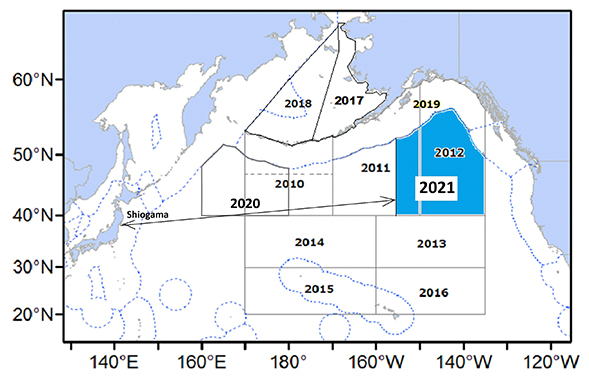
Figure 1. 2021 IWC-POWER survey area (blue) and course of round-trip voyage (black arrow). Other areas surveyed from 2010 to 2020 are also indicated.
2.4 International Researchers
Hiroto Murase (Cruise leader, Tokyo University of Marine Science and Technology, Japan)
James W. Gilpatrick, Jr. (Southwest Fisheries Science Center, NOAA/SWFSC, USA)
Isamu Yoshimura (IWC-nominated international researcher, Japan).
2.5 Research Vessel
Yushin-Maru No. 2 (747 tons, Captain Hiroshi Eguchi, 16 crewmen).
2.6 Total Distance Covered
1,562.5 nautical miles (approximately 2,893km).
2.7 Main whale sightings
Blue whale (6 goups, 7 animals), fin whale (77 groups, 113 animals), sei whale (23 groups, 37 animals), Bryde's whale (20 groups, 22 animals), sperm whale (14 groups, 14 animals), killer whale (1 group, 4 animals).
2.8 Results of sample collections, etc.
(1) Photo identification data (number of individuals)
Blue whale: 7 animals, fin whale: 31 animals, sei whale: 15 animals, Bryde's whale: 13 animals, killer whale: 3 animals (total 69 animals).
(2) Collection of biopsy samples (number of individuals)
Blue whale: 3 animals, fin whale: 9 animals, sei whale: 4 animals, Bryde's whale: 2 animals, killer whale: 1 animal (total 19 individuals).
(3) Whale diving behavior data logger attachments (number of individuals)
Fin whale: 2 animals, sei whale: 3 animals (total 5 individuals).
Photographs from the 2021 IWC-POWER cruise
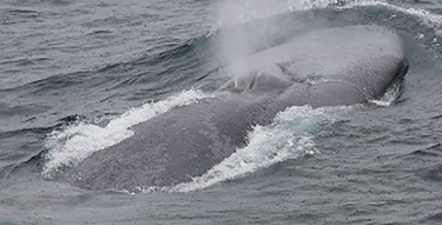 |
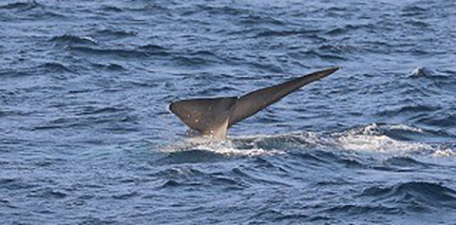 |
|
| A blue whale breathing at the sea surface. | A blue whale shows its fluke and dives. | |
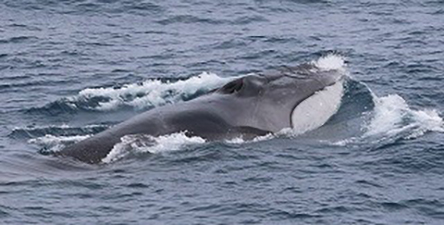 |
 |
|
| Fin whale coming to the surface. | Fin whale biopsy sample collection and attachment of the diving behavior data logger. |
Completion of the 2021 IWC/Japan Joint Cetacean Sighting Survey Cruise in the North Pacific - IWC-POWER (PDF file)
